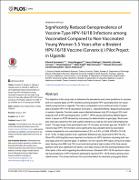| dc.contributor.author | Kumakech, Edward | |
| dc.contributor.author | Berggren, Vanja | |
| dc.contributor.author | Wabinga, Henry | |
| dc.contributor.author | Lillsunde- Larsson, Gabriella | |
| dc.contributor.author | Helenius, Gisela | |
| dc.contributor.author | Kaliff, Malin | |
| dc.contributor.author | Karlsson, Mats | |
| dc.contributor.author | Kirimunda, Samuel | |
| dc.contributor.author | Musubika, Caroline | |
| dc.date.accessioned | 2020-11-12T07:53:53Z | |
| dc.date.available | 2020-11-12T07:53:53Z | |
| dc.date.issued | 2016 | |
| dc.identifier.citation | Kumakech, E., Berggren, V., Wabinga, H., Lillsunde-Larsson, G., Helenius, G., Kaliff, M., ... & Andersson, S. (2016). Significantly reduced genoprevalence of vaccine-type HPV-16/18 infections among vaccinated compared to non-vaccinated young women 5.5 years after a bivalent HPV-16/18 vaccine (Cervarix®) pilot project in Uganda. PloS one, 11(8), e0160099. | en_US |
| dc.identifier.uri | https://hdl.handle.net/123456789/203 | |
| dc.description.abstract | The objective of this study was to determine the prevalence and some predictors for vaccine
and non-vaccine types of HPV infections among bivalent HPV vaccinated and non-vaccinated
young women in Uganda. This was a comparative cross sectional study 5.5 years
after a bivalent HPV 16/18 vaccination (Cervarix1, GlaxoSmithKline, Belgium) pilot project
in western Uganda. Cervical swabs were collected between July 2014-August 2014 and
analyzed with a HPV genotyping test, CLART1 HPV2 assay (Genomica, Madrid Spain)
which is based on PCR followed by microarray for determination of genotype. Blood samples
were also tested for HIV and syphilis infections as well as CD4 and CD8 lymphocyte
levels. The age range of the participants was 15–24 years and mean age was 18.6(SD 1.4).
Vaccine-type HPV-16/18 strains were significantly less prevalent among vaccinated
women compared to non-vaccinated women (0.5% vs 5.6%, p 0.006, OR 95% CI 0.08
(0.01–0.64). At type-specific level, significant difference was observed for HPV16 only.
Other STIs (HIV/syphilis) were important risk factors for HPV infections including both vaccine
types and non-vaccine types. In addition, for non-vaccine HPV types, living in an urban
area, having a low BMI, low CD4 count and having had a high number of life time sexual
partners were also significant risk factors. Our data concurs with the existing literature from
other parts of the world regarding the effectiveness of bivalent HPV-16/18 vaccine in reducing
the prevalence of HPV infections particularly vaccine HPV- 16/18 strains among vaccinated
women. This study reinforces the recommendation to vaccinate young girls before | en_US |
| dc.language.iso | en | en_US |
| dc.subject | HPV | en_US |
| dc.subject | Genoprevalence | en_US |
| dc.title | Significantly Reduced Genoprevalence of Vaccine-Type HPV-16/18 Infections among Vaccinated Compared to Non-Vaccinated Young Women 5.5 Years after a Bivalent HPV-16/18 Vaccine (Cervarix1) Pilot Project in Uganda | en_US |
| dc.type | Article | en_US |

